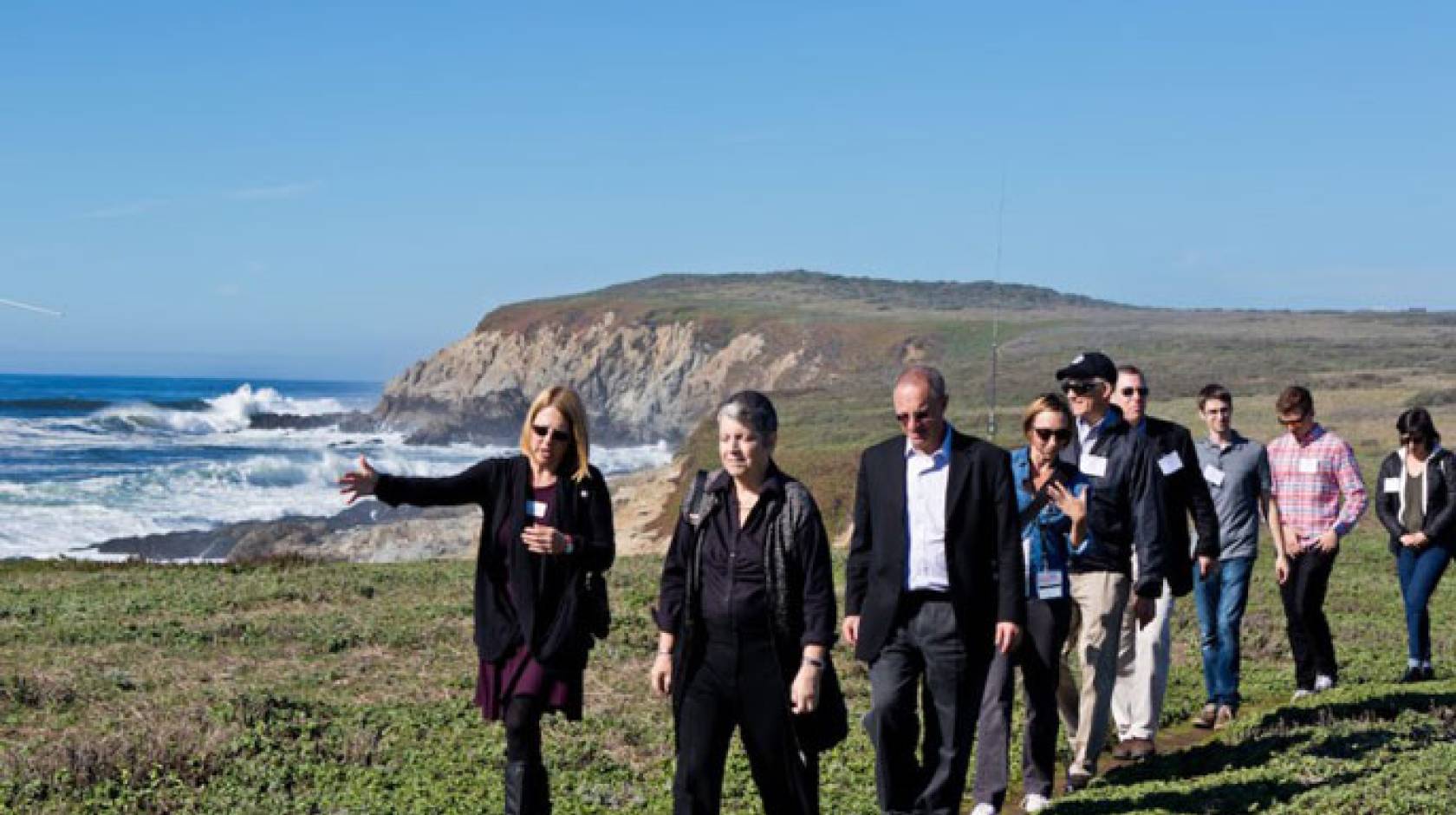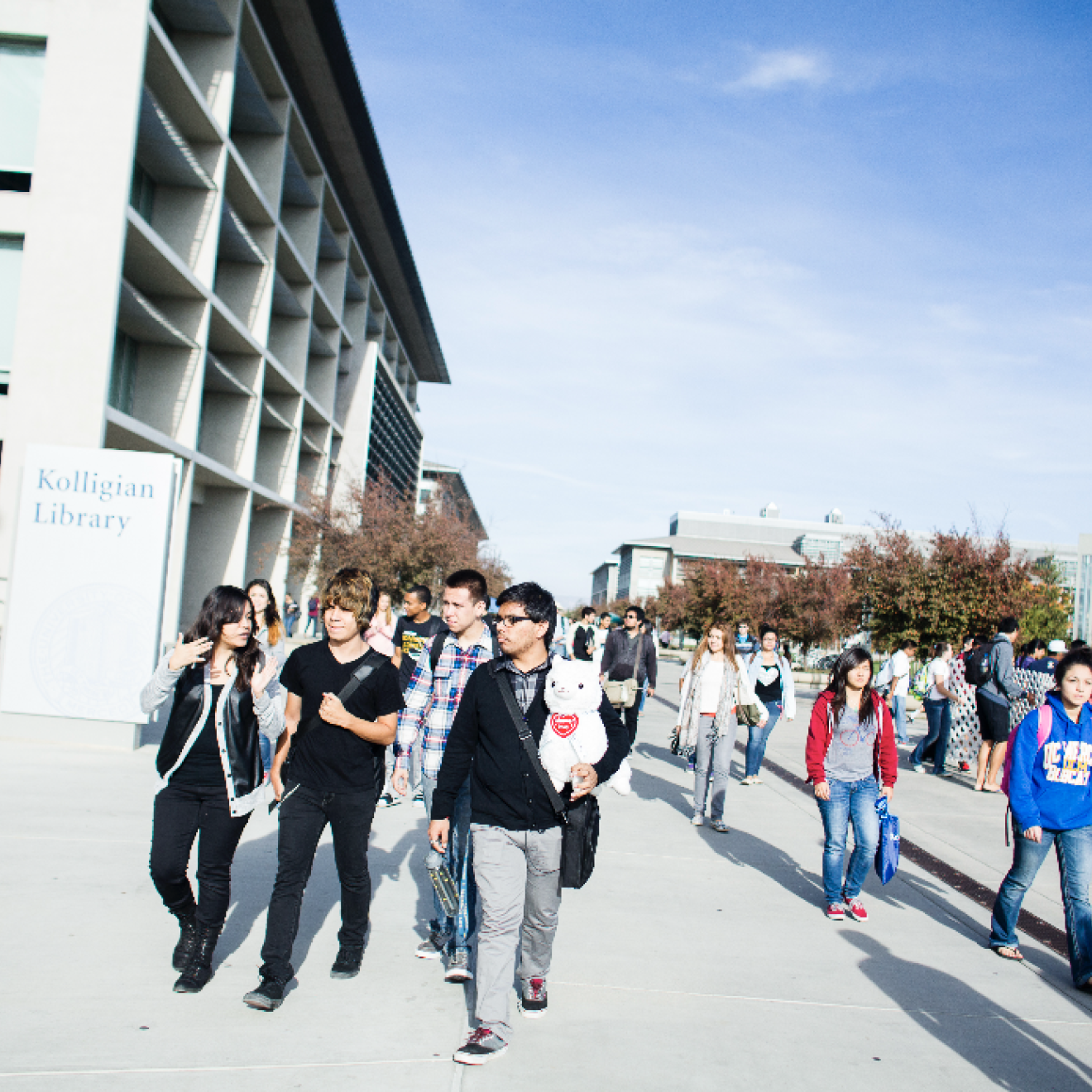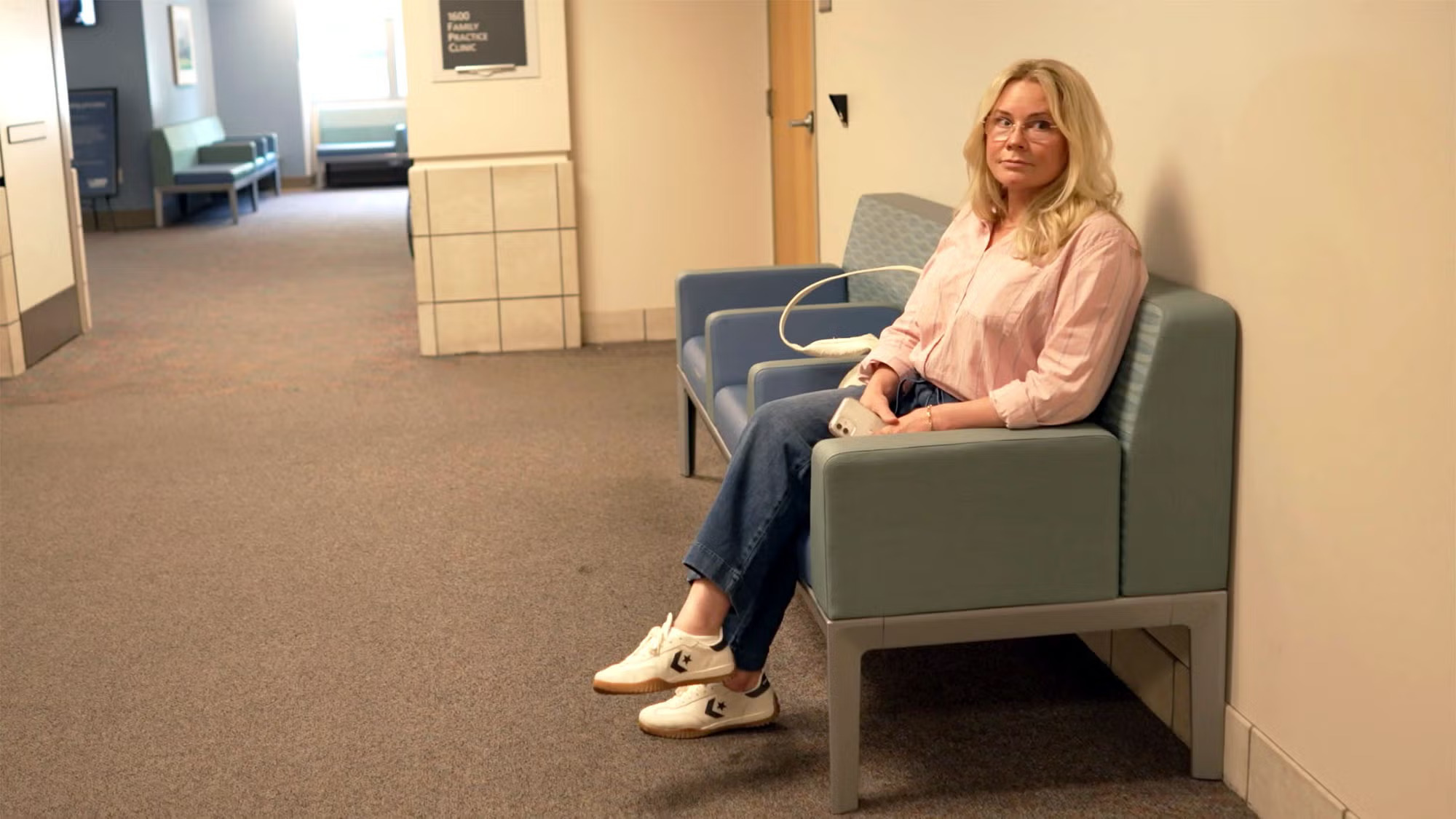Kathleen Wong, UC Natural Reserve System

University of California President Janet Napolitano visited Bodega Marine Laboratory and Bodega Marine Reserve to celebrate their 50th anniversary. Together, these sites are considered the premier place to conduct coastal and marine research in northern California.
The president was joined by lab and reserve staff, as well as UC Davis faculty and students, for a tour of the lab and the surrounding 362 acres of Bodega Marine Reserve. Along the way, the UC chief learned how the wildlands of the reserve complement the indoor lab facilities, and that this synergy fuels research into conservation, ocean processes, climate change adaptation, and other fundamental scientific questions. Both the lab and reserve are administered by UC Davis.
The day began with a whirlwind tour of BML facilities. First stop: the abalone lab, where Napolitano learned that in addition to growing happy cows, Sonoma County harbors happy abalone.
Bodega Marine Lab is ground zero for the effort to recover the species. Tender, tasty, and for centuries the star of coastal barbecues, it became the first marine invertebrate to be declared an endangered species in 2001.
Kristin Aquilino, biologist and head of the white abalone lab, used a kitchen spatula to remove a hand-sized shellfish from its tank. The three-year-old curled its giant foot and waved its eye stalks at the president. Charmed, the president smiled back.
Pampered abalone

Credit: Kristin Aquilino
Over the past four years, Aquilino and her staff have learned to breed the snails in captivity. Their production rate went from less than two dozen in 2012 to more than 10,000 juveniles this year. The idea is to start releasing lab bred abalone into the wild next year, to bolster a population where individuals are so rare that their sperm and eggs have no chance of meeting in the ocean.
In the lab, by contrast, abalone get the benefit of water treatment experts, spawning consultants, and even spa services: an annual exfoliation that removes potential pathogens followed by massage with protective beeswax and coconut oil. “These are the most pampered abalone in the world,” Aquilino boasted.
In an adjacent courtyard, UC Davis professor John Largier showed off a minibus-sized ocean buoy lying on its side like a fallen tree. This device and several others like it, he said, has illuminated how and where ocean currents flow along the northern California coast. In addition to how much water sloshes through the Golden Gate, it’s helping demonstrate how anomalies like the mass of warm water called The Blob affects processes like upwelling.

Credit: Lobsang Wangdu
“The Blob’s cap of warm water sits on the surface and prevents upwelling from bringing cold, fertilizer-rich water to the surface to fuel ecosystem growth,” Largier said. “The Blob was broken up by El Niño but looks to be setting up again. We’re studying the effect of The Blob on algae blooms and the crab fishery.”
The buoys “characterize how water moves in three dimensions. We’re working towards forecasting the effects of those ocean conditions,” said Rick Grosberg, a professor and director of Davis’s Coastal and Marine Sciences Institute.
This work has shown that coastal currents from northern California flow directly into the Bodega Bay and the Gulf of the Farallones National Marine Sanctuary. This discovery helped protect northern California waters from petroleum exploitation.
Answering questions by following the current
Knowledge of ocean currents is now helping to answer a longstanding question in marine science: do the microscopic larvae of fish, sea urchins, mollusks and other ocean organisms control their travels after hatching?

Credit: Lobsang Wangdu
The problem has been a tough nut to crack, said Bodega researcher and professor Steven Morgan. “They’re microscopic, we cannot put radio collars on them.” Yet Morgan and his colleagues believe that despite their size, planktonic larvae can control their travels.
To demonstrate that idea, Morgan and his collaborators developed what they call a robotic larva. They gutted fire extinguishers, sawed them in half, and outfitted the interiors with sensor brains and tracking equipment. Exterior propellers track current speed, while sensors on what look like tentacles detect salinity, temperature, and light levels. An exterior oil bladder controls the robot’s depth. By positioning the robot at different spots in the water column, the scientists can determine where each layer of current travels, and infer which currents plankton ride to optimal habitats.
“The scale of Bodega is just right,” said Largier, who is participating in the experiment. “We all know one another and collaborate on interdisciplinary projects like this one, and encourage our students to do the same.”

Credit: Lobsang Wangdu
A prime example of such a collaboration is an effort to understand how global warming is affecting ocean organisms. UC Davis professors Eric Sanford, Tessa Hill, and Brian Gaylord use their complementary expertise to move this complex research forward.
The issue is that recent increases in atmospheric carbon dioxide are causing seawater to become more acidic. Such low pH condition make it chemically unfavorable for marine animals such as oysters, abalone, and sea urchins to build their shells and skeletons.

Credit: Lobsang Wangdu
The researchers tackle the issue in a variety of ways, from growing animals in aquariums with higher levels of carbon dioxide, to installing equipment to monitor the pH of Bodega waters, to identifying genes that might help these invertebrates thrive in acidic seawater.
“Having our laboratories here and the natural laboratory of Bodega Marine Reserve just outside makes this place unique,” Hill said. The researchers can collect animals from reserve areas that already see low pH waters, and analyze them for aquaculture broodstock candidates. “There might be enough variation in natural populations here for some individuals to do better in tomorrow’s acidic oceans,” Hill said.
'Like Dr. Seuss land'
After lunch beneath the gaze of fish housed in lab aquariums, the group headed outside for a tour of Bodega Marine Reserve. It's one of 39 reserves in the UC Natural Reserve System, the largest university-administered reserve system in the world.
“This reserve has one of the highest uses in the Natural Reserve System due to the proximity of the lab and reserve,” said reserve director Suzanne Olyarnik. The convenience of being able to study animals in the wild, then bring them indoors to culture or analyze them in the lab, has made Bodega a coveted place to conduct research.

Credit: Lobsang Wangdu
She described how the university’s lands are only part of the healthy coastal habitats available to researchers. Several nearby parks, creeks, and Bodega Harbor draw a diversity of species ranging from badgers to pelicans to sardines.
Then there are the ocean habitats just offshore. “It’s like Dr. Seuss land down there,” Olyarnik said. “Things look so strange it’s hard to tell whether something is an animal or plant.”
These sections of the Pacific Ocean are protected as state marine protected areas and the Gulf of the Farallones National Marine Sanctuary. Reserve staff ensure waters in the state MPA remain free of fishing and collecting, and work closely with agency partners to inform management activities.
A brief stroll to the edge of the bluff afforded a sweeping view of foam-tipped waves, rocky tidepools, and green coastal prairie. A dozen harbor seals slid through the breakers just off the beach cove, as scarlet-beaked oystercatchers landed on exposed mussel beds.
Studying ocean acidification
Here, UC Davis graduate student Brittany Jellison described how she studies snails and starfish to study how ocean acidification affects predator/prey interactions. “Tidepools are particularly interesting because they are extreme environments. What is happening there now is exactly how climate change will affect coastal ecosystems,” she said.
Jellison went on to describe how the reserve was pivotal in her decision to attend UC Davis. “I came here the year before I began, saw how the reserve and lab functions, and the easy connection to campus, and the combination drew me to this place,” she said. “As I near graduation, I pinch myself every day to appreciate how great it is.”

Credit: Lobsang Wangdu
Back inside, Napolitano addressed the faculty, staff, and students who had gathered to meet her. “Bringing me out here on a day like to today was genius. I give you extra credit points,” she joked, referencing the balmy, sun-filled afternoon.
"This facility is on the cusp of some of the world's most critical issues: what happens in the oceans as temperatures rise, what this means for species, and how the world can continue to supply nutritious food to the extra billion people we will have over the next ten years," she said.
“The planet needs answers to inform public policy, and I’m confident the world’s grand challenges will be answered by science. To quote Matt Damon from The Martian, I want you to 'science the heck out of it.'”

